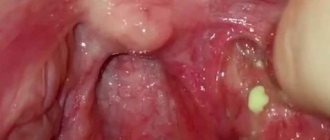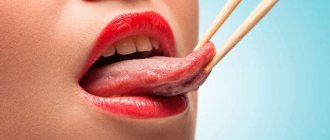A cracked lip in the middle not only spoils the appearance, but also causes pain. You will learn how dangerous the symptom is from the article.
The structure of the skin of our lips is very thin, delicate and sensitive. It is susceptible to negative influences: wind, heat, cold, etc.
If you do not properly care for your lips, you may feel chapped, uncomfortable, and your lips may peel and crack. To avoid this, you need to know and follow a few simple rules.
Why is my lip cracked in the middle?
- Manifestation of vitamin deficiency. A lack of vitamins belonging to groups A, B, E leads to impaired elasticity of the skin on the lips, as a result of which cracks may appear. In turn, vitamin deficiency can be caused by problems with the intestines and endocrine system, which leads to metabolic disorders or disruptions in the immune system. Hence, even a slight damage to the lip can cause cracks.
- A bad habit like smoking dries out your lips. Frequent licking, a strict diet, or snacking on the street can lead to the same result. The skin of the lips becomes dry, tightens, and the appearance of cracks is a natural result.
- The lip can crack as a result of using low-quality cosmetics or those that have expired. It is also possible to develop an allergy to decorative cosmetics, which can also cause cracks.
- Tooth decay is one of the reasons why lips become chapped. Bacteria that multiply in a diseased tooth spread to the lips, and if microtrauma appears on them, they are quite capable of increasing the negative effect. The same applies to fungal diseases.
- The mucous membranes and their condition depend on how the endocrine system works. Therefore, the presence of diabetes is also one of the reasons for the appearance of cracks on the lips. And a frequent desire to drink dries out your lips. To combat cracks in this case, it is recommended to take special medications.
- If a person has an incorrect bite , there may be accumulation of saliva in the corners of the lips, and consequently, their excessive moisture. If a crack appears on the lower lip, it is possible that the body is too polluted and it is necessary to undergo an examination of the gastrointestinal tract.
- Adverse weather conditions, prolonged exposure to the open sun or exposure to cold winds, sudden temperature changes. Cracked lip in the middle As a result of chapping and overdrying, dehydration occurs, both general and directly to the mucous membrane of the lips.
Due to external conditions - Unfavorable microflora , the presence of bacteria on the lips that destroy the structure of the skin, as a result of weakened immunity. The level of immunity decreases, in addition to the above reasons, also due to overwork, chronic lack of sleep, hypothermia, etc.
- Chemicals found in many food additives. Elementary common salt can “eat away” the skin of the lips to the point of ulcers, not to mention cracks.
- The influence of allergens of various origins, to which the skin of the lips often reacts negatively.
- Any mechanical impact . A bitten lip, an accidental prick from a fork, a cut - any damage to the lip can lead to a crack.
From exposure
Types of the disease, their symptoms
There are a large number of types of disease, each of which has its own symptoms. Cheilitis happens:
- catarrhal, resulting from injury. Its characteristic symptoms are redness, peeling, swelling and soreness of the lips.
- eczematous, developing due to the occurrence of eczematous processes. The reason is an allergy to a certain type of food, cosmetics (lipstick, cream).
- glandular, associated with an abnormality of the salivary glands. It happens that cheilitis on the lips accompanies periodontal disease, lupus, etc. The lower lip often suffers and begins to peel.
- meteorological. It is caused, as the name suggests, by weather conditions (high air humidity, strong wind, decreased or increased temperature, exposure to ultraviolet radiation, etc.).
- exfoliative, characterized by a chronic course. It is divided into two forms - dry (the blood supply to the lips is disrupted and, as a result, dry scales are formed, which can be easily removed, but after a few days they appear again) and exudative (the border swells and becomes inflamed, crusts appear).
- angular, called jam. Due to streptococci, inflammation begins in the corners of the lips. Vitamin deficiency and frequent licking of lips can also provoke it.
- atopic, accompanying atopic dermatitis. The red border of the lips flakes and itches, the lips crack.
- hypovitaminosis, which occurs due to a lack of B vitamins. Dryness and a pronounced burning sensation affect not only the lip area, but also the entire mucous membrane of the mouth, including the tongue. In this case, the mucous membrane turns red, and vertical cracks form in the area of the red border.
Regardless of the type of cheilitis, common symptoms will be:
- peeling of the lips, observed both only near the border and over the entire surface;
- swelling and swelling, burning and itching in the lips, the appearance of cracks and crusts on them.
How to treat a cracked lip in the middle: therapeutic agents
- If the lip is cracked in the middle as a result of a fungal disease, you should use appropriate antibacterial medications.
- This could be Tetracycline or methyluracil group, Levomekol, Vishnevsky balm.
- If there is no positive effect for a long time, you can try Purelan-100 , based on lanolin.
- Before using the drug, you should disinfect the damaged area and do not remove drying crusts on the lip.
- You can also use cream or Vaseline to soften and moisturize , lubricating the skin around the crack without touching it directly.
We soften
- This procedure must be repeated several times a day. Alternatively, you can replace Vaseline with pork fat.
In what cases is it important to stop self-medication and consult a specialist?
Experts warn that chapped lips are not only an aesthetic problem, but they can indicate the presence of diseases that we know about or not. Therefore, home treatment for dryness and small cracks on the lips must be stopped immediately and a visit to a medical facility should not be postponed in the following cases:
- If the condition of your lips does not improve after 2-3 weeks, you should find out the reason. Because it could be an allergic reaction to lipstick, lip balm or one of the ingredients in toothpaste.
- Herpes is the most common infectious disease of the lips. You must react at the first symptoms so that this pimple does not grow and damage your lips.
- If lips are persistently red, dry, or scaly, this may be a sign of an underlying systemic infection.
- If cracks or white spots systematically appear on the lips and corners, despite the use of a moisturizing balm. These signs may indicate a yeast infection: oral thrush, angular cheilitis, or thrush associated with a microscopic fungus.
My lip is cracked in the middle: what should I apply?
What to apply if your lip is cracked in the middle:
- Zinc ointment has an analgesic and disinfecting effect, relieves inflammation. From 3 to 5 times a day - and the wound will begin to heal. One “but”, check before using it to see if you have an allergic reaction or suppuration in the wound.
- Solcoseryl requires moisturizing after application. It has an analgesic effect and promotes rapid healing of the crack. Also monitor for any allergic reaction.
- Synthomycin . Quite an effective remedy with an antiseptic and analgesic effect. Due to many contraindications, it is better not to use this remedy without consulting a doctor.
- Bepanten . Recommended also for children, it has an anti-inflammatory effect, regenerates soft tissues.
Smear
Experts' opinion
As a result of clinical studies conducted, it was confirmed that La Cree lip balm:
- relieves discomfort and dry skin;
- restores dry and chapped lips;
- moisturizes and protects the delicate skin of the lips from cold and wind.
The conducted clinical study proves the high efficiency, safety and tolerability of products for daily skin care of children with mild and moderate forms of atopic dermatitis and during remission, accompanied by a decrease in the quality of life of patients. As a result of therapy, a decrease in the activity of the inflammatory process, a decrease in dryness, itching and flaking was noted.
Sources:
- Fokina R.A., Atopic dermatitis: stages of development of classification forms, Siberian Medical Journal, 2007
- A.N. Pampura, A.A. Chuslyaeva, Modern approaches to the treatment of atopic dermatitis in children
- Yukhtina N.V., Modern ideas about atopic dermatitis in children
Photos of diathesis
Photo album on the disease
How to treat a cracked lip in the middle: folk remedies
Cracked lip in the middle:
- You need to lubricate the crack with honey . Its softening and bactericidal effect has a beneficial effect on healing. This method is good if you are not allergic to the product.
- Use sour cream and olive oil , adding a couple of drops. Make a mask from this composition and leave it overnight. You can lubricate your lips with butter, and before going out - with Vaseline. By the way, you can prepare your own lip mask from these ingredients, taking three parts oil to one part Vaseline.
- tea tree ether is quite effective . If you add 2-3 drops to almond or peach oil and apply to the wound, healing occurs within a few days. If not, it means that the inflammatory process is developing, and then medical consultation is necessary.
- Mix vegetable oil with kiwi fruit pulp and apply this mixture to your lip for 20 minutes. Rinse off the mixture and dry your lips, and then moisturize them with a special product. If it doesn’t help, use a compress containing vitamins A and E.
- If a small child, especially an infant, has a cracked lip, the reason is most likely due to the composition of the mother’s milk. Therefore, mother should enrich her diet with vitamins. You can lubricate with cream, the main thing is that they do not contain fragrances or dyes.
- Home doctor - aloe flower is a universal healing remedy, including for lip cracks.
- Another universal remedy - tea rose petals, which are recommended even for infants with stomatitis. Soaked in warm milk for half an hour and ground to a homogeneous consistency, they heal cracks well when applied to the lips.
Petals - Echination tincture , and not necessarily from a pharmacy, but also from our own production. Just fill a third of a liter jar with crushed dry echinacea and add alcohol, vodka, moonshine - any strong composition. Leave it to brew for a couple of weeks and take it to boost your immunity before going to bed.
Treatment of stomatitis and cheilitis in children
Among diseases of the red border of the lips and oral mucosa in children, the most common are aphthous stomatitis and cheilitis.
Stomatitis, in turn, is divided into acute, subacute and recurrent. The pathological process can be represented by erythematous, vesicular-erosive, ulcerative or necrotic forms. The etiological and pathogenetic causes of stomatitis are very different, including mechanical damage to the oral mucosa.
However, as some authors note, aphthous stomatitis, which has an infectious-allergic nature, is more common. Clinically, it is manifested by the appearance of a round (up to 1 cm in diameter) inflammatory element in the form of a spot with a bubble on the surface, which eventually opens and forms erosion with rounded outlines, very painful, grayish-white or yellowish-gray in color.
The erosion is surrounded by an inflammatory ring; it heals within 1-7 days, leaving no traces. When the infiltrate is located around the salivary gland, the aphtha is represented by an ulcer with infiltrated edges and bottom; it heals within 2 months, leaving behind scars. Relapses of the disease often occur in the spring and autumn. The severity of the disease can increase over time: the number of aphthae increases and the duration of their healing reaches 2-4 weeks, relapses become more frequent. In children, this process is often accompanied by gingivitis and periodontitis.
Cheilitis is more common in children suffering from atopic dermatitis. The process involves the red border of the lips and the skin of the perioral area - this lesion is called atopic cheilitis. The area of the corners of the mouth is most affected, but the process never affects the oral mucosa. Patients initially experience itching, erythema with clear boundaries and swelling of the red border of the lips. Crusts may appear at the site of scratching. The symptoms of acute inflammation quickly subside, giving way to lichenification of the lips. The surface of the red border of the lips peels off with small scales and is cut by thin radial grooves; the skin in the corners of the mouth remains infiltrated for a longer time, which leads to cracks.
Treatment of this pathology, especially in children, should be comprehensive; Particular attention should be paid to the sanitation of foci of chronic infection in the oral cavity. Local therapy should include analgesics, antiseptics and epithelializing agents. Since the effectiveness of conventional drugs used in the treatment of aphthous stomatitis and atopic cheilitis is not high enough, we tried to find a drug that increases the effectiveness of therapy and is approved for use in children. Tablet forms of metronidazole have long been used in the complex treatment of gastritis, gastric and duodenal ulcers in pediatric practice, as well as in the treatment of amoebic dysentery, to stimulate reparative processes. The effectiveness of these drugs is explained by the possibility of influencing Helicobacter pylori and the gastritis caused by it [1].
The effectiveness of metronidazole in the treatment of periodontal diseases has been reported by a large number of authors. The drug turned out to be effective in the treatment of diseases associated with anaerobic flora, protozoa and bacteria; in addition, normalization of obligate flora in the oral cavity was noted [2, 3]. Good tolerability of topical oral metronidazole in combination with systemic antibiotics has also been reported in many studies.
The composition of the Metrogil Dent gel includes metronidazole, which has the above properties, as well as the antiseptic chlorhexidine, effective against gram-negative and gram-positive flora, lipophilic viruses, yeast and dermatophytes [4]. This combination explains the high effectiveness of the gel in the treatment and prevention of infectious diseases of the oral cavity. And since one of the reasons for the occurrence and recurrence of aphthous stomatitis is infection and, in addition, the duration of cheilitis, as a rule, depends on the addition of a secondary infection, the choice of this drug in the treatment of these diseases is the most optimal.
The convenience of using the gel in children is also due to the fact that the auxiliary substances included in its composition are menthol and sodium saccharin, which give the gel a pleasant sweetish menthol taste, and therefore the application of the gel does not cause negative emotions in children.
We use Metrogyl denta gel in the treatment of aphthous stomatitis in children. We observed 19 children with recurrent aphthous stomatitis aged 5 to 16 years. The drug was prescribed 3 times a day for aphthae. After applying the gel, patients were not recommended to rinse their mouths or eat food for 30 minutes. The effect was observed on the second day and was expressed in a decrease in pain and inflammation. Epithelization was observed within 3-5 days. As a rule, the process occurred against the background of diseases of the gastrointestinal tract and oral cavity, most often it was biliary dyskinesia and gingivitis. Thanks to the administration of Metrogil Denta gel for 10 days, 1 time at night, on the gums in 11 children, there was no relapse of the disease for 6 months. In 5 patients, the drug was used for primary aphthous stomatitis against the background of skin pyoderma, the effect was observed on the 3-4th day.
For cheilitis, the drug was prescribed to 15 children aged 5 to 15 years.
The drug was applied to the areas of inflammation 2 times a day, epithelization of the cracks occurred on the 4-5th day, after which the drug was taken once a day in combination with ceralin for 2 weeks. This combination of drugs made it possible to quickly stop acute manifestations of cheilitis, reduce itching and infiltration in the corners of the mouth, which made it possible to avoid the reappearance of cracks.
All patients had good tolerability of the drug, no side effects were observed, and in children of the younger group, application of the drug did not cause any negative emotions.
Based on the above, we can conclude that the use of Metrogil denta gel in the treatment of aphthous stomatitis and atopic cheilitis in children allows you to quickly and effectively cope with the acute manifestations of this pathology, avoid frequent recurrences and the addition of a secondary infection. In this regard, the drug can be recommended for use in pediatric practice as a highly effective remedy for the treatment of stomatitis and cheilitis.
Literature
- Guide: diagnosis and treatment of internal diseases. Medicine, 1999, vol. 3, p. 88.
- Ainamo J., Lie T., Ellingsen BH et al. Clinical responses to subgigival application of metronidazol 25% gel compared to the effect of subgigival scaling in adult periodontitis // J. of Clinical Periodontology. 1992. 19P12/: 723-9.
- Pedrazzoli V., Killian M., Karring T. Comparative clinical and microbiological effect of topical subgigival application of metronidazol 25% dental gel and scaling in the treatment of adult periodontitis // J. of Clinical Periodontology. 1992. 19/9P12/: 715-9.
- Baby N., Al Jasser N. Subgingival irrigation effect of chlorhexidine or sunguinarine and gingivitis in orthodontic patients // J. of Clinical Pediatric Dentistry. 1996 Spring. 20 (3): 225-8.
A child’s lip is cracked in the middle: what to do?
- What to do if a child’s lip is cracked in the middle? Among the remedies used to treat cracked lips in children, mothers recommend the same Bepanten , as well as Boroplus in the form of a cream. The only disadvantage of the latter remedy is the strong sandalwood smell, which not all children like.
- The methods described above using honey and Vaseline are also used for children. They can be used to lubricate your child's lips while sleeping.
The child has
Before going outside, you need to apply a special hygiene lipstick for children to your baby’s lips. All products must be tested to ensure there are no allergies to them.
If the crack does not heal for a long time, you need to make sure that the child drinks enough fluids and eats foods containing vitamin A. In addition, it is necessary to control that the air in the room where the child is is not too dry.
How to prevent your lip from cracking in the middle?
- Make it a rule before you go outside to lubricate the skin of your lips with special protective products (lipstick, balm, etc.) - this way you will moisturize your lips and protect them from drying out. Periodically apply vegetable oils or propolis to your lips.
Lubricate
- Don’t forget about vitamins : natural, found in seasonal vegetables and fruits, and as part of vitamin complexes purchased in pharmacies.
- Apply masks before bed, which, once absorbed, will prevent cracking on frosty days.
- Smoking really dries out your lips, especially if it happens outdoors, combined with exposure to wind or sunlight. Alcohol does not have a better effect on the skin of the lips .
- Poor quality or expired cosmetics can cause great harm. And you shouldn’t borrow lipstick from a friend - this is a purely individual product, like a toothbrush or comb.
Maybe from low-quality cosmetics
- If you notice that your lip is cracked in the middle , this happens often, and it takes a long time to heal - consult a specialist and strictly follow the procedures recommended by him.
Cracks on lips
10.04.2019
Modern dentistry is more than a medical institution.
Aesthetic services are consistently in demand among our patients. Teeth whitening and professional cleaning, installing sky bridges and straightening the smile line with veneers - all this is what our patients choose to look beautiful, young and well-groomed. At the same time, we, doctors, believe that true beauty always goes hand in hand with health. Today we want to talk about such a pressing problem as the appearance of cracks on the lips in the spring. The skin on the lips is thin and vulnerable, it does not have sebaceous glands, which means there is no fatty film that would protect against cold, heat or wind. Sometimes with the onset of spring, cracks appear on the lips. Probably every woman has encountered this phenomenon. Cracks spoil the appearance, cause inconvenience, interfere with a natural and open smile, causing discomfort. Today's UniDent article is about what causes them, how to prevent them and how to cure them at home yourself.
Why do cracked lips appear in spring?
The fact is that the delicate skin of the lips reacts to temperature changes, which are frequent during the changing seasons. In addition, spring vitamin deficiency plays a role, especially deficiency of vitamins A and E.
The skin of the lips also reacts to bad habits - smoking, love of strong coffee and salty foods.
In addition, some people have the habit of frequently licking their lips. Saliva, which contains enzymes and acids, also irritates and dries out the lips.
Dry, cracked lips can indicate certain diseases, such as diabetes. Therefore, if the cracks do not go away for a long time, it is better to consult a doctor.
If there are no diseases, but your lips are still cracking, you can try to cope with this problem yourself.
Preventing chapped lips
To protect your lips from the vagaries of the weather in spring, before going outside, you need to lubricate them with a protective balm or hygienic lipstick. The composition of such a product should be natural and include beeswax or vegetable wax, lanolin. These substances create a protective film.
Vitamins C and B12, as well as sun protection factor, will also help. It is better to choose a lipstick or gloss that contains these ingredients and renew the layer regularly.
It’s a good idea to nourish your skin with vitamins not only from the outside, but also to ensure they are supplied with food. To do this, you need to eat natural products, not fast food. The more varied the diet, the better for the skin. If you have to go on a diet, you can pick up a vitamin complex for yourself at the pharmacy.
Lip skin restoration
But what to do if there are already cracks? Engage in skin restoration and do everything for their speedy healing.
Those who are not allergic to honey can try honey masks. It takes a minimum of time. Just apply honey on your lips and wait 10 minutes - that's all. It’s even better if you apply this mask at night. Of course, not in a thick layer, but simply after applying the mask, walk around for a short time, then dry your lips a little with a napkin and, most importantly, do not wash off the mask completely.
A mixed mask - honey with olive oil - is useful and nutritious. This mixture can also be left overnight according to the same rules. The effect will be noticeable, the cracks will heal quickly.
It’s a good idea to lubricate your lips with oil alone, this will also benefit the skin.
A salt compress before bed is suitable for care. Dissolve half a teaspoon of sea salt in a glass of water, moisten a cotton swab with this mixture and press it to your lips for 5 - 10 minutes. Then apply oil or rich cream.
Regular care will help get rid of unpleasant cracks in the skin of your lips, look well-groomed and make your smile healthy and beautiful.
We wish you to smile joyfully and enjoy your health every spring day!
With love, UniDent.
Share information with friends:
Cracked lip in the middle: does it need to be treated?
- Such microtrauma does not seem worth close attention to us, so many people ask the question: is the lip cracked in the middle - does it need to be treated?
- The answer to this question can be either positive or negative, depending on many circumstances.
- So, if a crack in your lip appears once and quickly heals on its own, and you do not feel any particular discomfort when eating, talking, or facial movements, you should wait a day or two without resorting to medications.
- If cracks begin to appear frequently , even if they heal quickly, it is best to consult a specialist, because it is possible that the problem indicates a malfunction in the body.
Should I treat the crack?
- By eliminating the initial cause determined by the doctor, you will also get rid of the appearance of cracks on your lips without additional effort.
- Well, and, of course, deep wounds that do not heal for a long time must be treated, again, having previously examined your body to see if everything is okay with it and whether there are any malfunctions in the functioning of any organ.
Cracked lip in the middle: a sign
Signs about what a crack on the lip means developed in ancient times and have survived to this day.
- Is your lip cracked in the middle? A sign of recent passionate kisses . This is explained by the fact that girls have long applied honey or wax coating to their lips to protect them from wind or sunlight. Before the date, this layer was washed off so that the lips were soft and natural. Deprived of their usual protection, and even under the influence of a hot kiss, their lips easily cracked, thereby betraying the secrets of the girl’s heart.
- Evil eye . Everyone has long known that a person who has been “jinxed” becomes vulnerable to negative influences. And all these factors negatively affect health, including skin condition. Therefore, it has become a custom to interpret the appearance of a crack on the lip as one of the signs that a person has been exposed to the evil eye.
- There is another interesting sign that warns you about what needs to be done to prevent your lips from cracking. You just need to kiss the ground at the first spring thunder . The sign says that this action will protect your lips from cracking (and, by the way, from toothache) for a whole year.
- There is also an interpretation of a dream in which you saw a crack in your lip. Such a dream speaks of impending troubles: failures, separations, unnecessary spending.
The main reasons why lips are damaged
The skin consists of several layers: hypodermis, dermis and epidermis. This last surface layer is designed to protect against aggressive external influences, since it consists of a hydrolipid film, partly produced by the sebaceous glands.
There are no sebaceous glands or melanocytes on the lips. It is for these reasons that lips are especially sensitive, easily damaged and most susceptible to external aggression (rain, wind, cold, etc.).
The extent of lip damage depends on the degree of dryness. A slightly dehydrated lip will look a little dry. Slight peeling may then appear. As dehydration continues, flaking becomes more intense, giving the lips a pale appearance. Finally, as dry skin becomes more severe, cracks may appear on the lips, which can cause bleeding. At this point, the person begins to feel pain with every movement of the mouth.









